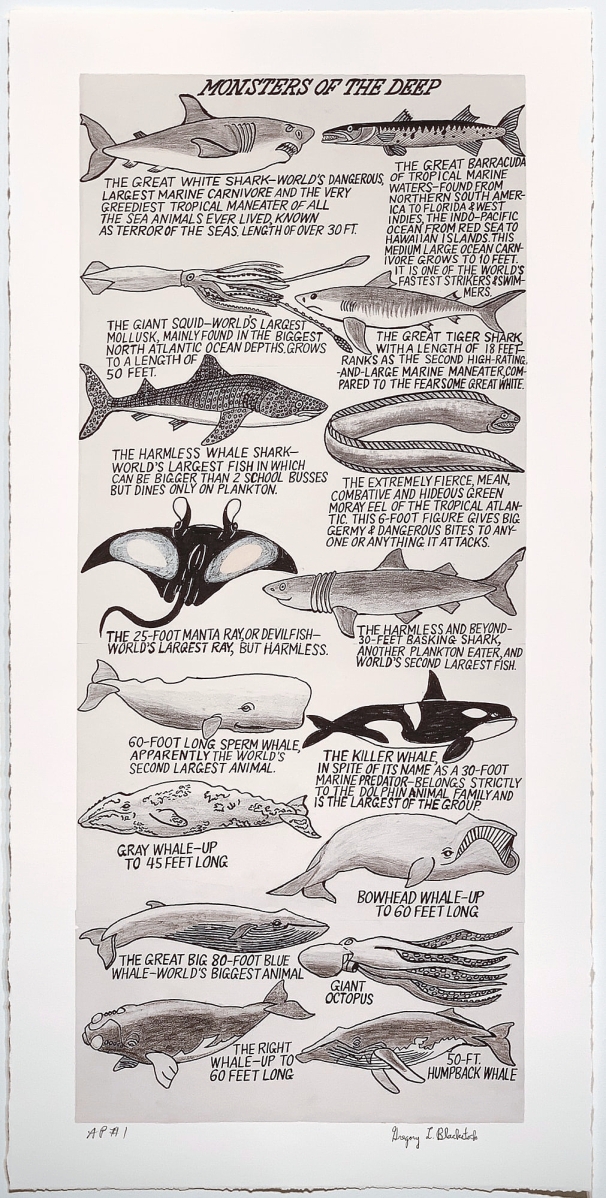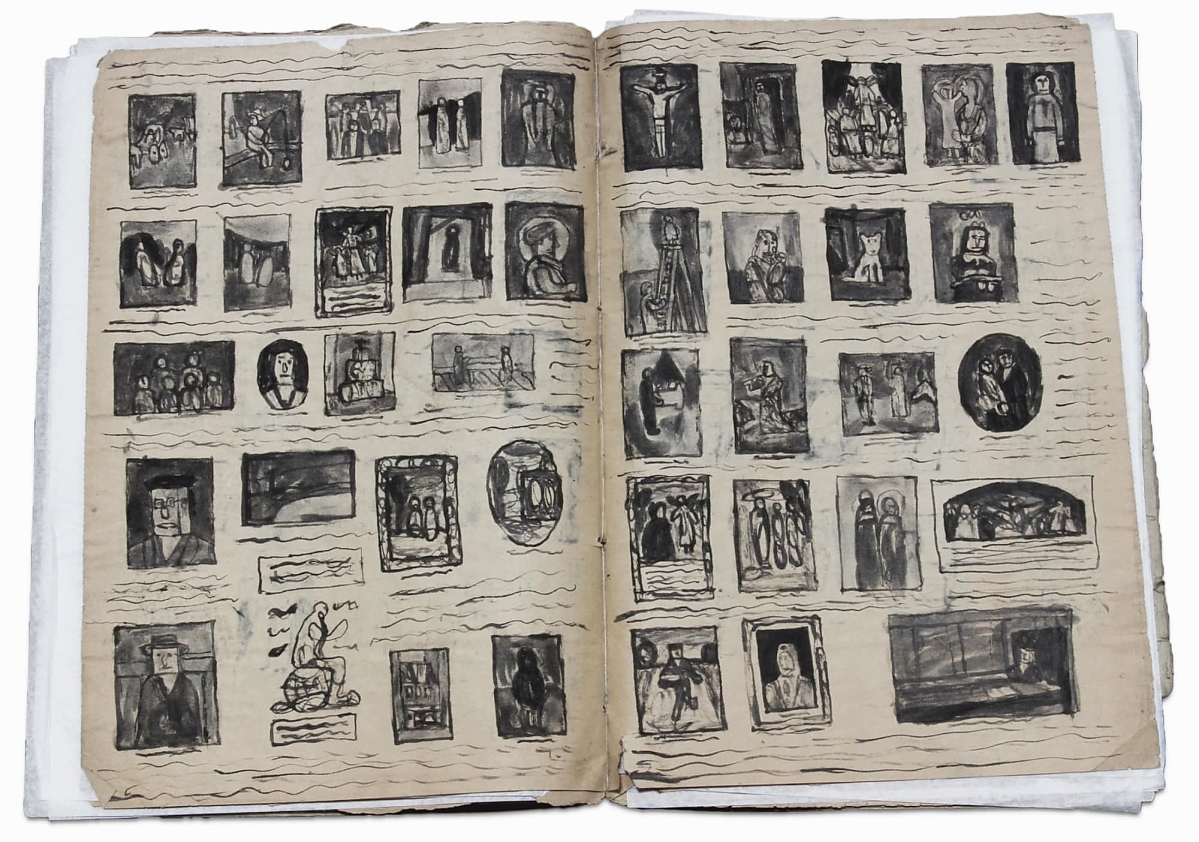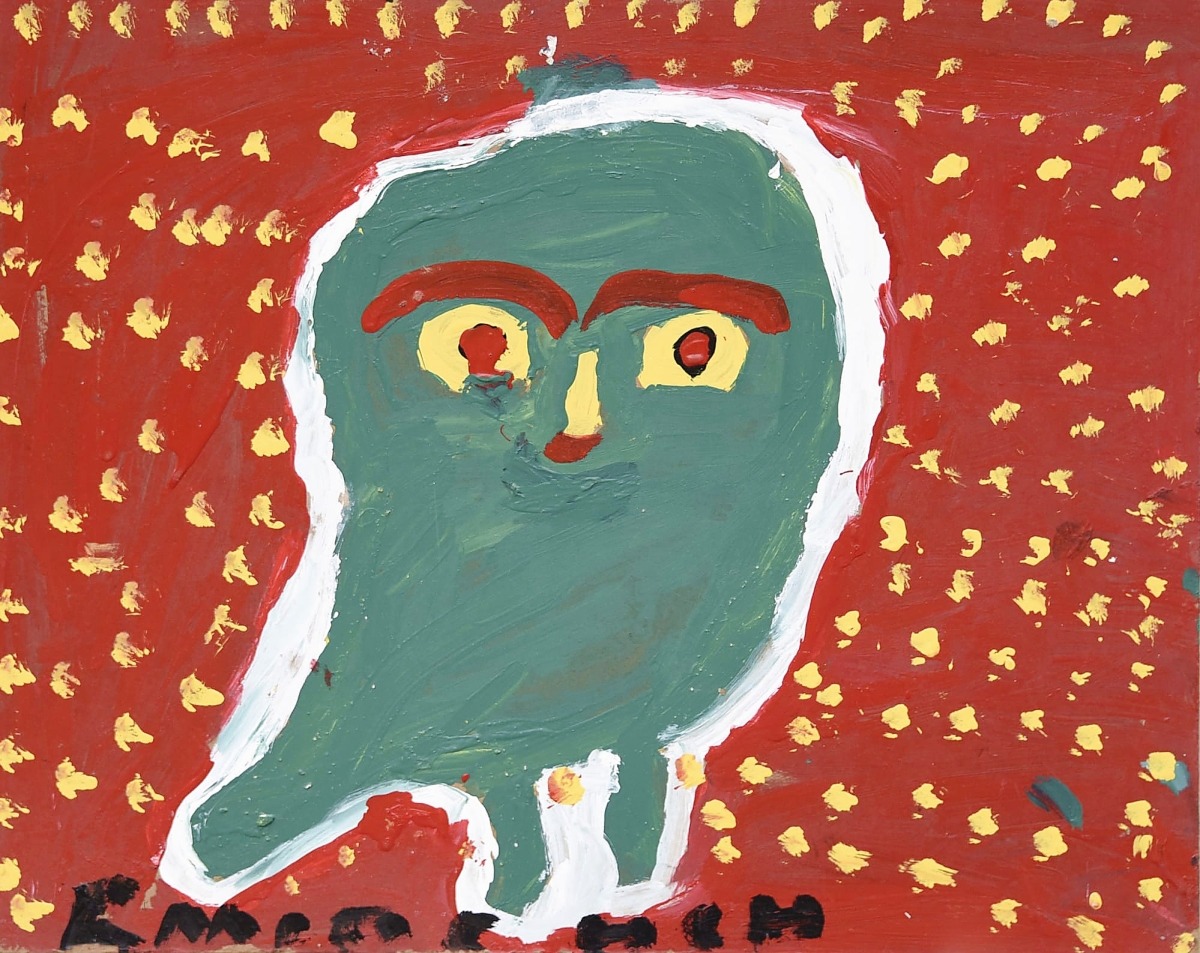
Installation view of “Figure Out: Abstraction in Self-Taught Art” on view at Andrew Edlin Gallery as part of the Outsider Art Fair 2021. The exhibition featured a dozen self-taught artists including Dan Miller, Eugene Andolsek, Hiroyuki Doi, Daniel Goncalves and the Gee’s Bend Quiltmakers. Photo Credit: Olya Vysotskaya
Review by Greg Smith, Photos Courtesy The Outsider Art Fair
NEW YORK CITY & ONLINE – The Outsider Art Fair (OAF) delivered a hybrid show model from January 29 to February 7, inviting visitors in New York City into five physical venues while offering artworks from 45 exhibitors in online viewing rooms on its website at www.outsiderartfair.com.
The New York show comes just three months after the Paris edition, also a hybrid model with an in-person exhibition held at Hotel Drouot in 2020. Both were debuts for the fair’s new director, Nikki Iacovella, who assumed the helm this past September in a rather novel environment for the show circuit.
We caught up with Iacovella about seven days into the show’s 10-day run.
“It has been a fun challenge,” she said. “We learned a lot in Paris, the in-person show was well received and we felt there was something there. We wanted to expand on that model in New York and bring it to numerous venues, give it more locations and bring it back to the galleries. We’ve had a really steady stream of visitors into the galleries and that trickles through to the viewing rooms. Both are linked.”

Based in Tehran, Iran, the Outsider Inn Gallery is the only gallery dedicated to Art Brut and self-taught artists in the country, it says. Alireza Asbahi Sisi (b 1969), aka CC, began working in clothes manufacturing after the fifth grade following his father’s death. When he was 35, he began selling carpets at a bazaar. Now he works as a driver while creating “kilim-arts,” which encompasses the work here, an untitled sewing and collage on carpet.
Five in-person exhibitions featured two solo and three group shows, the latter formed with material from a number of participating galleries spread throughout the country.
The show’s curated space was among the solo shows, offering the works of the late musician and self-taught artist Daniel Johnston in the space of Electric Lady Studios, a recording studio in Greenwich Village founded by Jimi Hendrix. Johnston aspired to be a comic book artist, many of his works featuring heroic storylines or chat bubbles with characters such as Thor and Captain America. The organizers wrote, “The same cartoon frog and monsters with eyes on extensors show up again and again, along with a more innocent type of guy with the top of his skull removed – from which other characters emerge in psychedelic profusion.”
On East 57th Street, Hisrchl & Adler mounted “To Be Human: The Figure in Self-Taught Art,” which featured work culled from their own inventory, James Barron Art, Cavin-Morris Gallery, Andrew Edlin Gallery, Marion Harris, Ricco/Maresca Gallery and SHRINE. It featured works from Hawkins Bolden, Jeanne Brousseau, Eugene Von Bruenchenhein, James Castle, Henry Darger, Guo Fengyi, Vera Girivi, William Goldman, Josef Hofer, Issei Nishimura, Reza Shafahi, Mary T. Smith, Janet Sobel, Mose Tolliver, Bill Traylor, Frank Walter, Purvis Young, Elisabetta Zangrandi and David Zeldis.
Tom Parker, associate director at Hirschl & Adler, said, “the fair has been a real bright spot for us in what is otherwise a fairly difficult period, it’s been a positive experience on a number of levels.”

Installation view of “Small World” at Shin Gallery as part of the Outsider Art Fair 2021. At bottom are works by John Byram beneath drawings by James Castle. Photo Credit: Olya Vysotskaya
He noted that at least a couple hundred people have come through the exhibition since the fair opened and that the slower pace – when compared to a regular fair – is not such a bad thing.
“We’ve had some nice conversations with collectors, critics and other dealers. People come in and they spend extra time, it’s quiet and you can talk with them in a way that you can’t at a fast-paced, noisy art fair with lots of distractions. It’s really easy to focus on the works and have a deeper interaction with them.”
Parker said the gallery had good interest in the work of Frank Walter (1926-2009), the Antiguan artist, writer, philosopher and poet who spent the final decades of his life living in a self-made home atop a mountain. He produced more than 1,500 objects and 25,000 pages of writing. H&A offered at least three landscapes from Walter, including a valley view and two others that seemingly centered on the same view at different moments: a picket fence before a dark blue sky and the same fence before a bright red sky. Walter posthumously represented Antigua at the country’s first appearance at the Venice Biennale in 2017 and received a 2020 retrospective at the Museum MMK in Frankfurt, Germany.
Sherry Pardee of Iowa City’s The Pardee Collection offered the architectural renderings of Jim Work (b 1944) and the whimsical figures and animals of Emitte Hych (1909-2009). Pardee also mentioned the ability to have longer conversations with collectors as they inquire about works from the online viewing rooms.

Hirschl & Adler had success with selling the Antiguan artist Frank Walter. This is one of two works featured in the gallery’s viewing rooms centered on a picket fence landscape. This example with a red sky, the other with a dark blue night sky. Oil on photographic paper, 5 by 8 inches.
“I find that in the quiet of my home I am able to explore these works more,” she said. “I’m able to talk with people more in depth, some for hour-long conversations. And some of these people have been to the fair before and maybe didn’t notice the same artist they are now looking at. In the online fair, they have more of a chance to study them that they wouldn’t necessarily have had in the live fair.”
Pardee remembers meeting Emitte Hych in the early 1990s. “In the early days, I was driving about 60,000 miles around the country following leads, going place to place, driving randomly and talking to a lot of people. In those years, the people of Emitte’s generation were still alive and working. One woman in a town told me there was an elderly Black man who had a lot of art in his yard that he made. I drove by and he was out gardening, he had a ¾-acre garden, and he asked me if I’d like to see some of his drawings. From there we built a great friendship that lasted until he died in 2008.”
Many of Hych’s scenes center on figures and animals, most always people he didn’t know and animals he could not and did not care to classify.
“His delightful, joyous spirit comes out in his work,” Pardee said. “A lot of customers really enjoy living with his work and come back for more of it. He has a very graphic style of design, very clean, a lot of visual impact and bold use of color. It was very intuitive.”

Installation view of “To Be Human: The Figure in Self-Taught Art” at Hirschl & Adler as part of the Outsider Art Fair 2021. The exhibition included work by Hawkins Bolden, Jeanne Brousseau, Eugene Von Bruenchenhein, James Castle, Henry Darger, James Edward Deeds, Guo Fengyi, Vera Girivi, William Goldman, Josef Hofer, Issei Nishimura, Reza Shafahi, Mary T. Smith, Janet Sobel, Mose Tolliver, Bill Traylor, Frank Walter, Purvis Young, Elisabetta Zangrandi and David Zeldis. Photo Credit: Olya Vysotskaya
Pardee’s sales were light when we spoke to her, but she said she had inquiries and expected sales to pick up in the final weekend of the show, just as they had in Paris, when collectors start to feel the pressure of the clock dwindling.
Hych’s works were featured in “Keep Your Lamps Trimmed and Burning,” a group exhibition of Southern self-taught Black artists curated by SHRINE’s Scott Ogden and on view at New York City’s Shin Gallery, one of three Outsider Art Fair exhibitions at the venue. Ogden said, “The title of the show is from a gospel blues song, but the reference really matches the drive of all self-taught artists, particularly these. Keeping the lamps trimmed and burning, keeping everything moving forward.”
Others in the show included Hawkins Bolden, Thornton Dial, Rosena Finister, the Gee’s Bend Quiltmakers, Bessie Harvey, Frank Jones, Ronald Lockett, Prophet Royal Roberston, Mary T. Smith, Mose Tolliver and Bill Traylor.
Shin Gallery is a new face at the Outsider Art Fair this year, and its two other exhibitions included “Small World,” with a selection of small-scale works from Morton Bartlett, Joe Coleman, Tom Duncan, Madge Gill, Daniel Gonçalves, Cleophas Lachance, Raphael Lonné, Jordan Laura Maclachlan, Ray Materson, Miroslav Tichy, Melvin Way, Domenico Zindato and others. Its other exhibition is a solo show dedicated to North Carolina artist Minnie Evans. “The Realm of Minnie Evans” pulled from the collection of Christian P. Daniel, a Wilmington, N.C., collector who holds one of the largest private collections of the artist’s works.
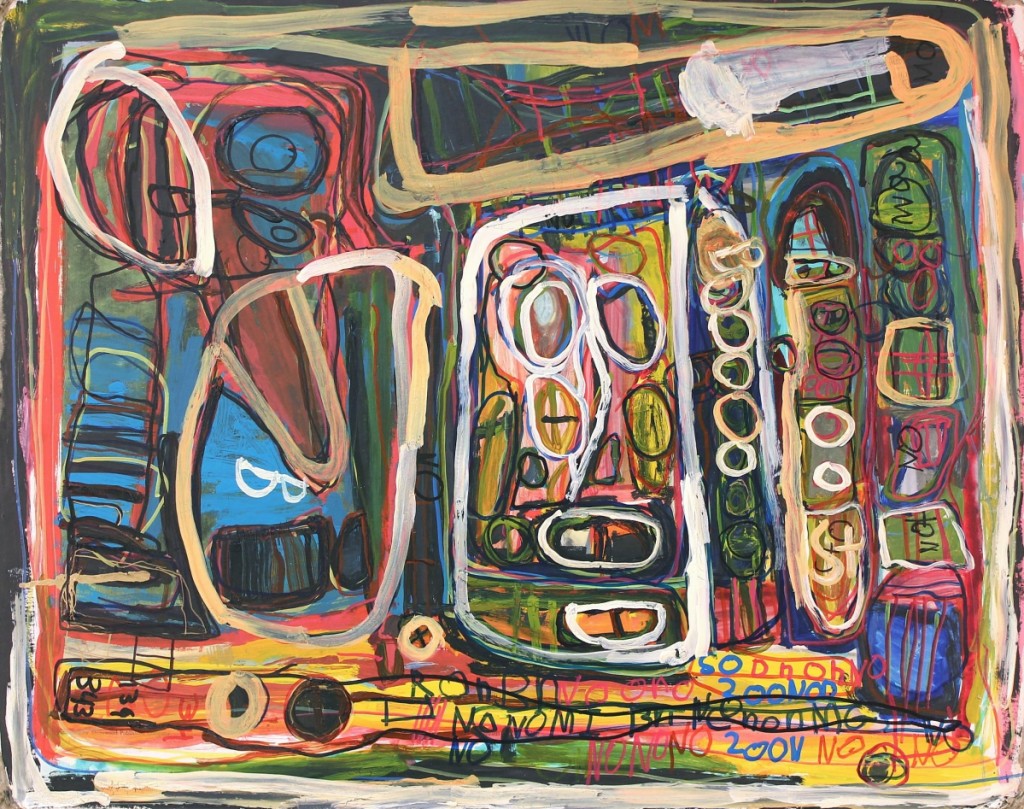
The Center for Creative Works featured art by Brandon Spicer-Crawley, with at least two sold. Born in 1980, the gallery describes Spicer-Crawley as an improvisational artist who “develops an electric series of marks emanating outward, creating vibrating, dynamic spaces.” Among the sold was “Houses,” a 22-by-28-inch acrylic painting on top of found mounted poster of Edward Hopper’s “7 AM.”
“Everyone that comes through loves Minnie,” said Shin Gallery director Stavroula Coulianidis. “This is the first time in years she’s had a solo exhibition with this many high-quality pieces. Christian hand selected the best for this show.”
Also new to the fair was the Seattle-based Greg Kucera Gallery, which was offering prints by artist Gregory Blackstock as part of “The Incomplete Historical World” series. Blackstock, also of Seattle, created a series of taxonomic drawings over a period of 30 years that centered on cataloging different types of the same thing, ie a single drawing featuring eight different types of piranhas. Other taxonomic works included penguins, art supplies, big cats, artichokes and classic cars. That Blockstock now lives in a care home and has not produced an original drawing in at least a year made for an opportune time to introduce the market to a series of prints, all signed by him and done in editions.
“There is editorializing in his works,” said Kucera, “because he’s interested in the ones that interest him. That’s not every classical car ever, but those that interest him. I enjoy the ‘Monsters of the Deep’ or ‘The Notorious Harmful-To-Man Plants.’ Superlatives are interesting to him, the danger or the excitement. He didn’t do the pretty fish, he did the piranhas or the barracudas. Those things with a stronger impact.”
Kucera said interest in the print series is strong and that he plans to mount a physical exhibition on them in the summer.
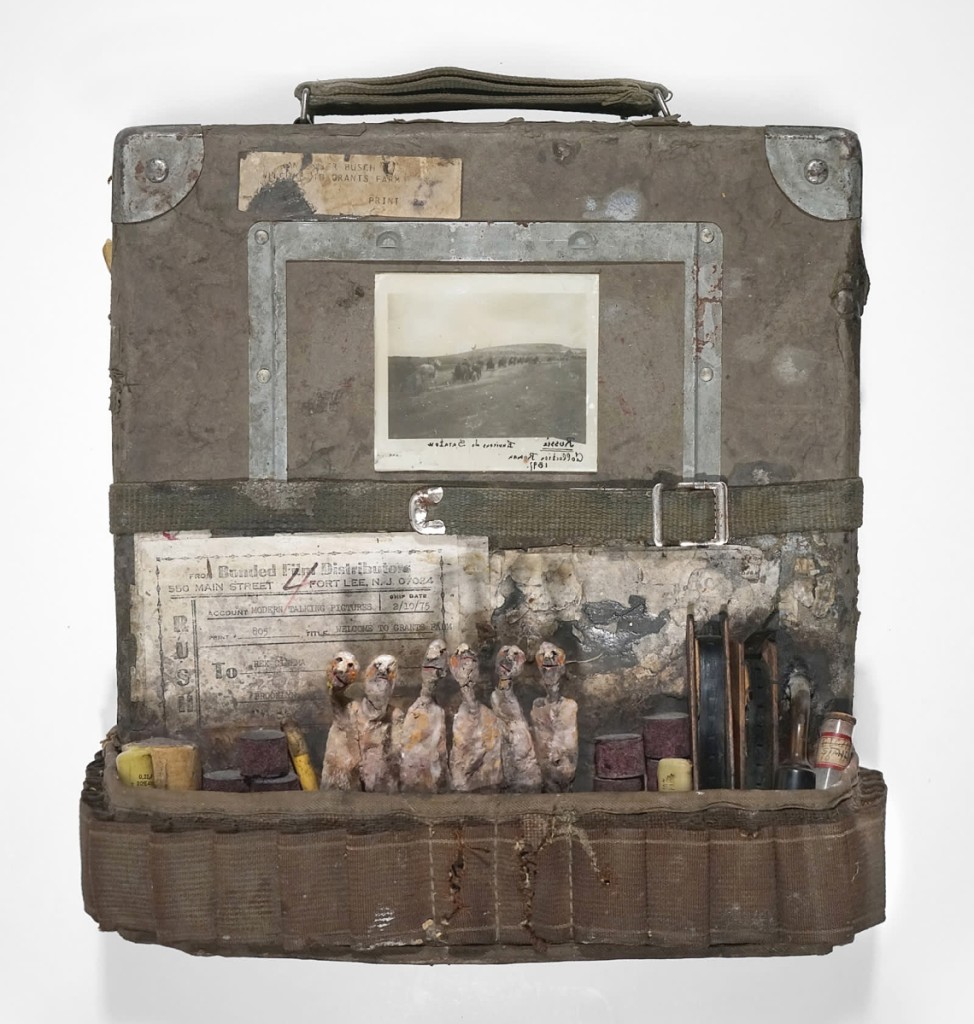
French born assemblage artist Gerard Cambon (b 1960) was on show with Koelsch Gallery. “Cinema,” mixed media, 13 inches high.
A selection of works from New York state self-taught artist Andrew “Grandpa” Pfriender (1909-1986) was offered from one of his patrons, artist and curator Doug Beube. Around 1982, while teaching at the Chautauqua Art Institute, Beube found himself in an Arts & Crafts shop staring down Pfreinder’s work as the gallery owner said that he would no longer be representing the artist. A phone call later, Beube was driving to Pfriender’s home in the backwoods of Loch Sheldrake, N.Y.
“We were so surprised by how humble, funny and modest he was,” Beube said. “He took us into his home, it was a large trailer home, and he had artwork that was stacked in a separate room from floor to ceiling. You couldn’t walk into the room, they were stacked like cities. He would tell us to just go through the work and we were like little kids in a candy store.”
Pfreinder’s work centered on things he saw in media, including magazines or the news. He knew of art and artists, including Van Gogh, which Beube said he would pronounce like “Gogg” – a product of reading without conversing – and also Matisse. “He said there was a Grandma Moses but there was no grandpa, so he was Grandpa Pfreinder,” Beube said. “The ones we gravitated towards were famous artists, museums, God, Elvis and stories about his life. Andrew expressed through his technique the best he could, he was fearless. His materials were anything, he would use Styrofoam, his wife’s fabric, acrylic watercolor, gouache. He painted flat objects or circular objects and the beauty of each piece is that there is a story written about each. I asked him once why he used text, and he said people wouldn’t understand if he didn’t tell the story.”
In “Monumental Renewal Project On Our Lady,” the artist created a sculpture with found materials featuring a rising central metal object with scaffolding around it. The work was based on an image Pfreinder saw when the Statue of Liberty was being conserved. A carved and painted bus with painted nuns inside was titled “The Day I Saw Nine Nuns In Northport.”

Sold for Henry Boxer was “Nokta Vision” by Margot, a mixed media work measuring 40 by 28 inches from the artist’s “Tra Miaj Manoj” series. Margot, a French artist, began drawing every day, all day, in 2014 in a burst she described as “frenetic and furious.”
Pfreinder’s work was largely bought by artists during his life, Beube noted. “He was so delightful. He had no mental illness, he was just so high on life and the excitement of being able to express what he read and what he saw.”
Over in the United Kingdom, Henry Boxer had an industrious showing with 14 sales chalked up by the Friday before the show closed. Included in his offerings were the automatic and highly detailed drawings of Margot (b 1982), a French artist that Boxer believes has mediumistic qualities. “She loses herself when she paints and the work contains a mystery that communicates another realm,” Boxer said. Margot began drawing in 2014, her artist statement describing it as “a torrent…frenetic and furious.” Margot entered the collection of the American Folk Art Museum this past November.
Seven of Boxer’s sales came from a series of drawings by an anonymous foot fetish artist, many of them centered on women. “These were acquired from an English private collector who found them in a Berlin auction – anonymous works in discarded folder without any history, but with a singular deviant vision,” Boxer said. “I imagine a lone individual creating these in secret for an audience of one, himself. That is the dark beauty of true art brut. Also his use of photo-montage is exciting and sophisticated, and reminds me somewhat of Miroslav Tichý, another art brut creator who constructed his own private aberrant erotic world.”

Contemporary artist Alyson Vega was represented at Fountain House Gallery. Three of her works were from the “We Are All in this Together, Apart” series that the artist created in 2020. Vega said, “The idea for this series came from all the public service announcements I saw on TV during the early part of the pandemic. Famous people trying to reassure us that we were all experiencing the same thing. I was cynical and depressed at the beginning. I couldn’t fathom the extent of suffering going on all over the country, the world. As time went on, I felt closer to people knowing how all of our lives are on hold.” Handmade fabric and thread figures hand- and machine-sewn to layered fabric background.
For other established galleries, the fair passed somewhat quietly. Carl Hammer of Chicago related some inquiries but no sales at press time. Among the works shown with him was a carved wood plaque from Ulysses Davis (1913-1990) featuring a Zodiac sign, “Aquarius,” the figure appearing before a starry background as he pours water from an ancient jug.
“It’s an iconographic work for Davis,” Hammer said. “It shows his range, dexterity and visionary qualities. Of all the pieces we have in the show, that has received the most response.”
The fair was also slower for Frank Maresca of Ricco/Maresca Gallery, who can normally be found at the fair holding court just off the opening avenue with red dots sprinkled throughout his walls.
Among works by blue chip artists, including Traylor and Ramírez, Maresca was showing art from Domingo Guccione (1898-1966), an Argentine musician and mystic. “All of his works are exercises in abstraction that he visualized in this rather spiritual or mystical kind of way,” Maresca said. “He viewed them as music.”

“His delightful, joyous spirit comes out in his work,” Sherry Pardee said of Emitte Hych, whose work was represented by The Pardee Collection. This example featured an owl, though some of Hych’s other animals are ambiguous.
“Explanatory Marks, The Mystical Drawings of George M. Silsbee,” Maresca’s independent exhibition presented with Steven S Powers, currently on at his gallery, has been fruitful, he noted. Silsbee is being hailed as a recent discovery, his work from the second half of the Nineteenth Century centering on Masonic symbolism. Maresca noted that Silsbee’s work was likely not endorsed by any lodge, nor even made for one – it was a personal body of art based in Masonic ritual, though with an evolved language and imagery all his own.
Other in-person exhibitions at the fair included “Semotioic Terrain: Art from Australia and New Zealand” at Salon 94 Freemans, featuring the work of Alan Constable, Julian Martin, Mantua Nangala, Yukultji Napangati, Susan Te Kahurangi King and Warlimpirrnga Tjapaltjarri.
Andrew Edlin, the fair’s owner, hosted “Figure Out: Abstraction in Self-Taught Art” at Andrew Edlin Gallery. The exhibition highlighted abstract works from artists who also worked in representational images, including work by Dan Miller, Eugene Andolsek, Hiroyuki Doi, Daniel Goncalves and the Gee’s Bend Quiltmakers.
“I look forward to one day bringing thousands of people into the Metropolitan Pavilion and expanding and refining the fair in its traditional sense,” Nikki Iacovella said. In the future, she hopes to expand the fair’s footprint across Manhattan as well as expand the fair, through this hybrid model, into different cities throughout the United States.
“I’m excited for the future,” she said.
For additional information, www.outsiderartfair.com or 212-337-3338.



